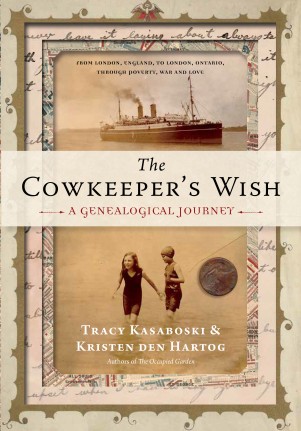
Often when we visit with writers’ and researchers’ groups, we talk about the importance of layering your resources when you build a big multi-generational story like The Cowkeeper’s Wish. If you want to tell a social history as well as a family saga, as we were keen to do, you need to dig for details in all kinds of different places — in the census, birth and death records, of course, but also in the newspaper archive and in war diaries and philanthropist’s notebooks and so on and so forth. When we first began this project, we never imagined how many resources we’d use to search for clues to our family’s past. It is a thrilling experience, I can happily report. You start to feel a little like a detective when you do this kind of work, and the more practiced you become, of course, the better you are at sleuthing. I’m working on a new book now — not family-based this time, but also non-fiction, and set at the end of WW1, so I am using many of the same resources and approaches we used for The Cowkeeper’s Wish, and also realizing that I am hooked on telling true stories pulled piece by piece from the past. There’s no better job for someone who loves crumbly rippled ledgers and curled photographs and maps with streetnames that no longer exist.
Tracy has this same pull to the past, and so we were both delighted to see the cover design for The Cowkeeper’s Wish, which is in its own way a layering of resources. The images were cleverly put together by Anna Comfort O’Keeffe at Douglas & McIntyre, and each one she selected has a meaningful connection to the story.
The frilled gold on the outer edge of the cover image, as you can see here, comes from our grandmother’s baptismal certificate. You can see it is signed by E. C. Carter — that’s the Reverend Ernest Courtenay Carter, who died just two years later on the Titanic. The family story goes that he and his wife Lilian (who my grandmother was named for) were dear friends of the family — though that’s probably not really true, since they came from very different backgrounds at a time when background really mattered. More likely, they were enormously admired by our family members, who must have been devastated when they died. The connection gave us a fresh new way to weave the story of the Titanic into our own tale.
This next layer in from the outer edge is a letter written by our great uncle, Joe Deverill, in 1923, saying goodbye to his younger siblings as they leave England for Canada. He offers brotherly advice — “mind who you mix with on the boat” — and urges them to remember that “although the (Old Home) has broken up we are still Sisters and Brothers and I would like you to write and let me know how you get on.”
Next in from Joe’s letter is a portion of Charles Booth’s poverty maps, made as part of his Inquiry into Life and Labour in London. Social investigators colour-coded the city as to level of poverty: black streets were vicious and criminal, dark blue were very poor with chronic want, on up to light blue, purple, pink, red and finally yellow, reserved for the wealthy upper classes. Booth’s maps, and the notebooks his investigators used to record their findings as they prowled the city, were an excellent way for us to “see” the neighbourhoods we were writing about.

The cover also features an image of the Metagama, the ship our grandmother came to Canada on, in the care of a family friend. It was 1919, and the ship had only recently been used as a troop carrier.
Below the Metagama is a photograph of our grandmother as a girl (with bathing cap), playing at the beach with her new Canadian friend. Beside them floats the lucky penny our great uncle Joe had kept in his pocket the day the Mary Rose sank. This mix of personal and historical imagery is an excellent fit with the book itself, which is both an intimate family story and a social history.
After years of research, seeing all these pieces of the puzzle worked into the cover image for our book was a lovely surprise, and still serves as a reminder of the many places that hold clues to the past for those who love to go searching.










Thank you for explaining the intricacies of your beautiful book jacket! Such thought and care for the details of the story made for a lovely “decopage” of family and historical treasures. Well done!
LikeLiked by 2 people
Thank you for your comment, Nancy. Douglas & McIntyre really did do a wonderful job. We were thrilled with their subtle and beautiful design, and even more pleased that it included so many bits of our family treasures.
LikeLiked by 1 person
Thank you Nancy!
LikeLike
Beautiful cover holding a beautiful story written by beautiful sisters.
LikeLiked by 1 person
😀
LikeLike
Pingback: A Halifax Man – The Cowkeeper's Wish